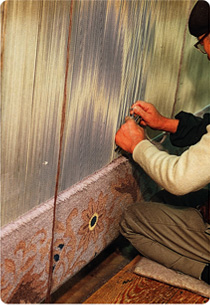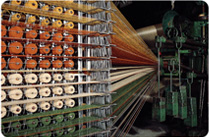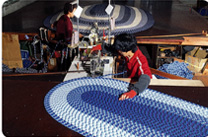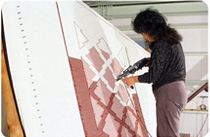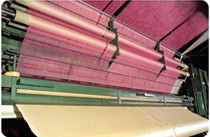Modern day Sakai carpets originated from the 19th century Sakai-style hand-woven carpets which evolved from 'Sanada-Himo' braids.
Sakai-Style Hand-Woven Carpets and Rugs
Sakai's carpet industry is said to have originated from the Sakai-style hand-woven carpets created by Soemon Fujimoto, a haberdasher of Sanada-himo in 1831. He created the Sakai-style after studying both the Chinese and the Nabeshima-styles.
In 1877, Soemon's grandson Sotaro exhibited the Sakai-style hand-woven carpet in the First Industrial Exposition and received high acclaim and recognition.
Production of Sakai-style hand-woven carpets grew from 120 tatami mat-sized pieces in the 1830s to 891,225 pieces in 1895. The figures continued to grow, and soon Sakai became the top producer of carpets for export in Osaka prefecture. Thus, Sakai-style hand-woven carpets played an important part in the acquisition of foreign currencies.
Rug types such as the rag rug, yarn rug and hooked rug gained popularity in the early 20th century. From around 1955, the trend shifted to tube mats, Wilton carpets and tufted carpets, and Sakai gained recognition as Japan's "Carpet Kingdom".
Sakai's carpet industry today is working hard to develop new materials, as well as automating and computerizing their system in order to produce a wide variety of carpets to meet the varied needs of the time.
Carpet Classification (by Size)
- Carpet
- All types of large sized floor coverings. Usually covers the entire floor of a room.
- Mat
- Small sized floor covering. Door mats and bathroom mats are good examples.
- Rug
- Medium sized floor covering. Often placed in front of the fireplace.
Woven Carpets
Non-Woven Carpets
- Wilton Carpet
- First made in Wilton, England in the mid-18th century. When the Jacquard loom (a loom to weave elaborate design) was invented in the 19th century, this carpet's popularity increased. The pile thread is woven with many layers of warp and weft, making a thick and sturdy carpet.
- Tube Mat
- The first of this type of mat was probably made in Kawabe-gun, Hyogo Prefecture in 1922. The tube mat is made from tubes sewn together. The tubes use recycled fabric in the core, around which thread is coiled like an electric cord. It is well liked for its elasticity, solid appearance and reversibility.
- Hooked Rug
- Kobe was the center of this type of rug manufacturing in the late 1920s. Just like embroidery, this type of rug uses an electric hookgun to stick pile yarns into the base fabric. Since it is done manually, intricate designs that would be impossible with a machine can be easily made. At present, high tech robots are succeeding humans in this market.
- Tufted carpet
- A highly productive carpet manufacturing method using several thousand sewing machine needles to push and attach the pile yarn into the base fabric. At first, designs were difficult to produce, however as technology improved, so did the designs. Mass production started around 1955.
Major Types of Carpet
[Manufacturers' Associations]
●Osaka Special Textile Manufacturing Association
693-5, Higashiyama, Naka-ku, Sakai 599-8247
Phone: (072) 235-5396




